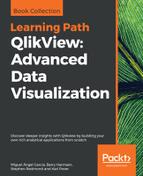 Summary
by Karl Pover, Stephen Redmond, Barry Harmsen, Miguel Angel Garcia
QlikView: Advanced Data Visualization
Summary
by Karl Pover, Stephen Redmond, Barry Harmsen, Miguel Angel Garcia
QlikView: Advanced Data Visualization
- QlikView: Advanced Data Visualization
- Table of Contents
- QlikView: Advanced Data Visualization
- Contributors
- Preface
- 1. Performance Tuning and Scalability
- Reviewing basic performance tuning techniques
- Generating test data
- Understanding how QlikView stores its data
- Strategies to reduce the data size and improve performance
- Testing chart performance for different load options
- Optimizing chart calculation times
- The QlikView calculation engine
- Using Direct Discovery
- Testing scalability with JMeter
- Running an example execution
- Summary
- 2. QlikView Data Modeling
- Reviewing basic data modeling
- Dimensional data modeling
- Differentiating between facts and dimensions
- Understanding the grain
- Understanding star schemas
- Summing with facts
- Discovering more about facts
- Dealing with nulls in fact tables in QlikView
- Designing dimension tables
- Defining Kimball's four-step dimensional design process
- Learning some useful reusable dimension methods
- Creating dimensional facts
- Handling slowly changing dimensions
- Dealing with multiple fact tables in one model
- Drilling across with document chaining
- Summary
- 3. Best Practices for Loading Data
- Reviewing data loading concepts
- Understanding why you should use an ETL approach
- Using an ETL approach to create QVD data layers
- Mastering loading techniques
- Using QlikView Expressor for ETL
- Summary
- 4. Advanced Expressions
- Reviewing basic concepts
- Understanding Dollar-sign Expansion
- Using advanced Set Analysis
- Calculating vertically
- Summary
- 5. Advanced Scripting
- Reviewing the basic concepts
- Counting records
- Loading data quickly
- Applying variables and the Dollar-sign Expansion in the script
- Using control structures
- Examining advanced Table File Wizard options
- Looking at data from different directions
- Reusing code
- Summary
- 6. What's New in QlikView 12?
- 7. Styling Up
- 8. Building Dashboards
- User types
- Applying the DAR principle to Airline Operations
- Creating the Analysis sheet
- Creating the new Dashboard sheet
- Creating the Reports sheet
- Other charts
- Summary
- 9. Advanced Data Transformation
- 10. Security
- 11. Data Visualization Strategy
- 12. Sales Perspective
- 13. Financial Perspective
- 14. Marketing Perspective
- 15. Working Capital Perspective
- 16. Operations Perspective
- 17. Human Resources
- 18. Fact Sheets
- 19. Balanced Scorecard
- 20. Troubleshooting Analysis
- 21. Mastering Qlik Sense Data Visualization
- Index
This has been an intense chapter, but you've hopefully achieved a deeper understanding of data visualization in QlikView and familiarized yourself with the basics of building frontend dashboard, analyses, and reports in QlikView.
We started with the Analysis sheet, for which we created basic data visualization objects like bar, line, combo, and scatter charts. We also learned how to create container objects, statistics boxes, and buttons, and explored more in-depth chart properties, expressions, the expression editor, and expression overview.
Next we built the Dashboard sheet, where we learned how to create gauges, text objects, and pie charts, while also learning about linked objects, actions, and dimension limits.
The final sheet that we built was Reports; here we learned how the straight table, pivot table, and table box objects are created. Additionally, we also learned about variables, cyclic and drill-down groups, auto minimizing, and the Report Editor.
We concluded this chapter by looking at some of the chart types that weren't included in our QlikView document, and what the typical use case for these chart types is.
-
No Comment